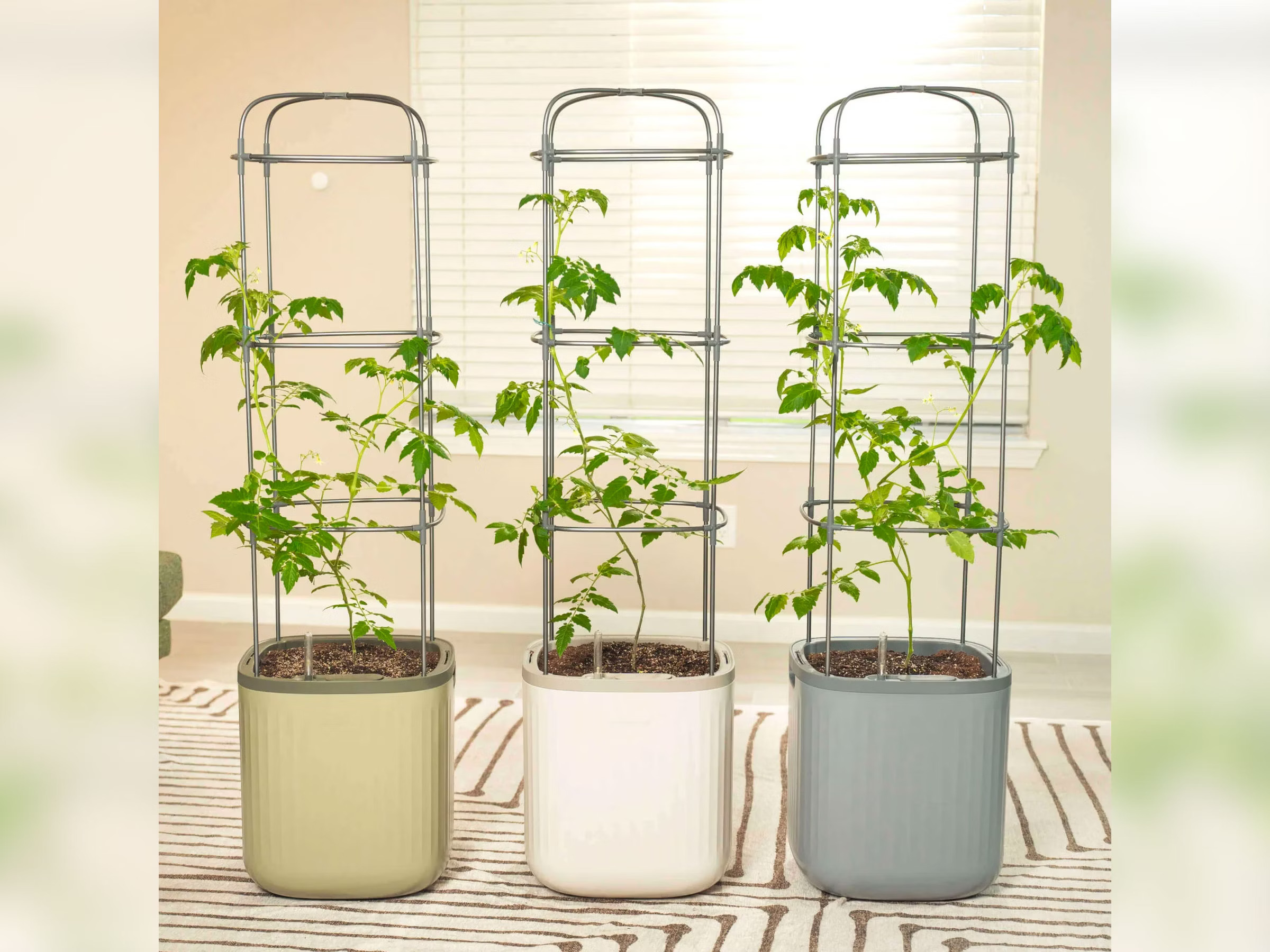Tomato Diseases Every Gardener Should Know – And How To Treat Them
Tomato disease can be traced to one of four causes: fungal, bacterial, viral, and environmental. Learn to identify them and fight back.
- Common Tomato Diseases
- Fungal Tomato Diseases
- Fusarium Wilt
- Anthracnose
- Blight
- Molds and Mildews
- Bacterial Tomato Diseases
- Bacterial Spot
- Bacterial Canker And Wilt
- Viral Tomato Disease
- Alfalfa Mosaic Virus
- Curly Top Virus
- Tobacco Mosaic Virus
- Tomato Spotted Wilt
- Environmental Tomato Issues
- Frequently Asked Questions
Tomato diseases can be a major threat to the production of fruit. Diseases on tomato plants may be infectious diseases caused by bacteria, fungi, viruses or nematodes or non-infectious, caused by physical, chemical or environmental or other factors that result in tomato plant problems. Control of tomato plant diseases is predicated on recognizing the symptoms and differences between infectious and non-infectious diseases. Keep reading to learn how to identify and control tomato diseases.
Common Tomato Diseases
A variety of factors from harmful pathogens to environmental issues can cause common tomato diseases resulting in everything from cosmetic damage to eventual death of the plant. Learning the symptoms of these common tomato diseases will help the gardener to manage issues and diseases that may crop up when growing tomatoes.
Fungal Tomato Diseases
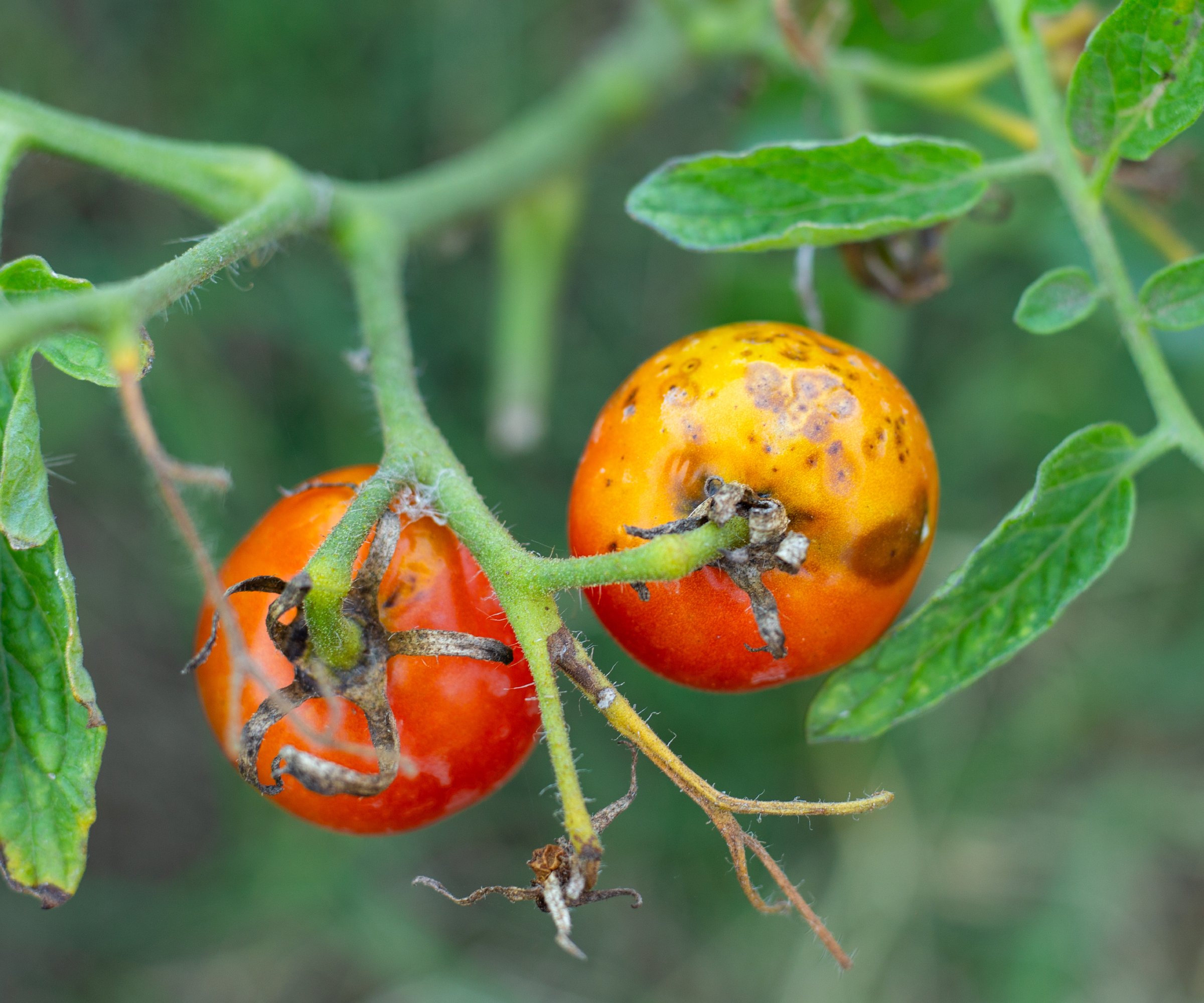
Fusarium Wilt
Fusarium wilt is a fungal disease that disrupts the uptake of water. Initial symptoms are yellowing of the lower leaves followed by wilting and leaf drop. As the disease progresses it moves up the stem of the plant, killing all the foliage. With no way to photosynthesize, the plant expires.
This fungus overwinters in soil and is also spread through seed. It is facilitated by warm temps between 80-90 F (27-32 C), sandy soil and air movement from winds, water or garden tools.
Crop rotation along with the use of resistant seeds can limit the progression of fusarium wilt. Otherwise there is no cure for the disease. Bag up and dispose or burn infected plants. Do not put infected plants in the compost pile.
Verticillium wilt presents with the same leaf symptom but attacks both sides of the plant at once. Many hybrids are resistant to these two tomato plant diseases.
Anthracnose
Anthracnose is a common disease in tomato plants. It demonstrates as small circular, bruised spots on the skin that invite other fungi to infect the interior of the fruit.
Sign up for the Gardening Know How newsletter today and receive a free copy of our e-book "How to Grow Delicious Tomatoes".
Blight
Southern blight is caused by the pathogen Sclerotium rolfsii which has a huge host range of more than 200 species. This devastating disease rapidly results in wilt of the entire plant.
Southern blight begins as water-soaked lesions on the stem at the soil line. The stem lesion is covered with a white mold accompanied by brown sclerotia. As the disease progresses the lesions brown, grow and eventually girdle the stem.
This disease is fostered by high humidity, moist soil and temperatures from 85-95 F.
The sclerotia germinates in the soil and then colonizes near the soil surface. Because of the large number of sclerotia in the soil, Southern blight is difficult to control. Crop rotation reduces the incidence of the disease. Also fungicide applications can help to control the disease.
Early blight begins as small black lesions on the leaves and soon forms concentric rings like a target. This tomato disease's telltale mark is found at the stem end of the fruit which will turn black. Late blight usually occurs when late-season temperatures cool and dew is heavy, with dark water-soaked spots on the leaves. The fully formed fruit rots on the vine before it fully ripens.
In the case of any fungal disease, removing any plant debris from the site can help reduce the fungal pathogens as can keeping the area weed free. Sanitize garden equipment as well and rotate nightshade crops each year for 3-4 years.
Molds and Mildews
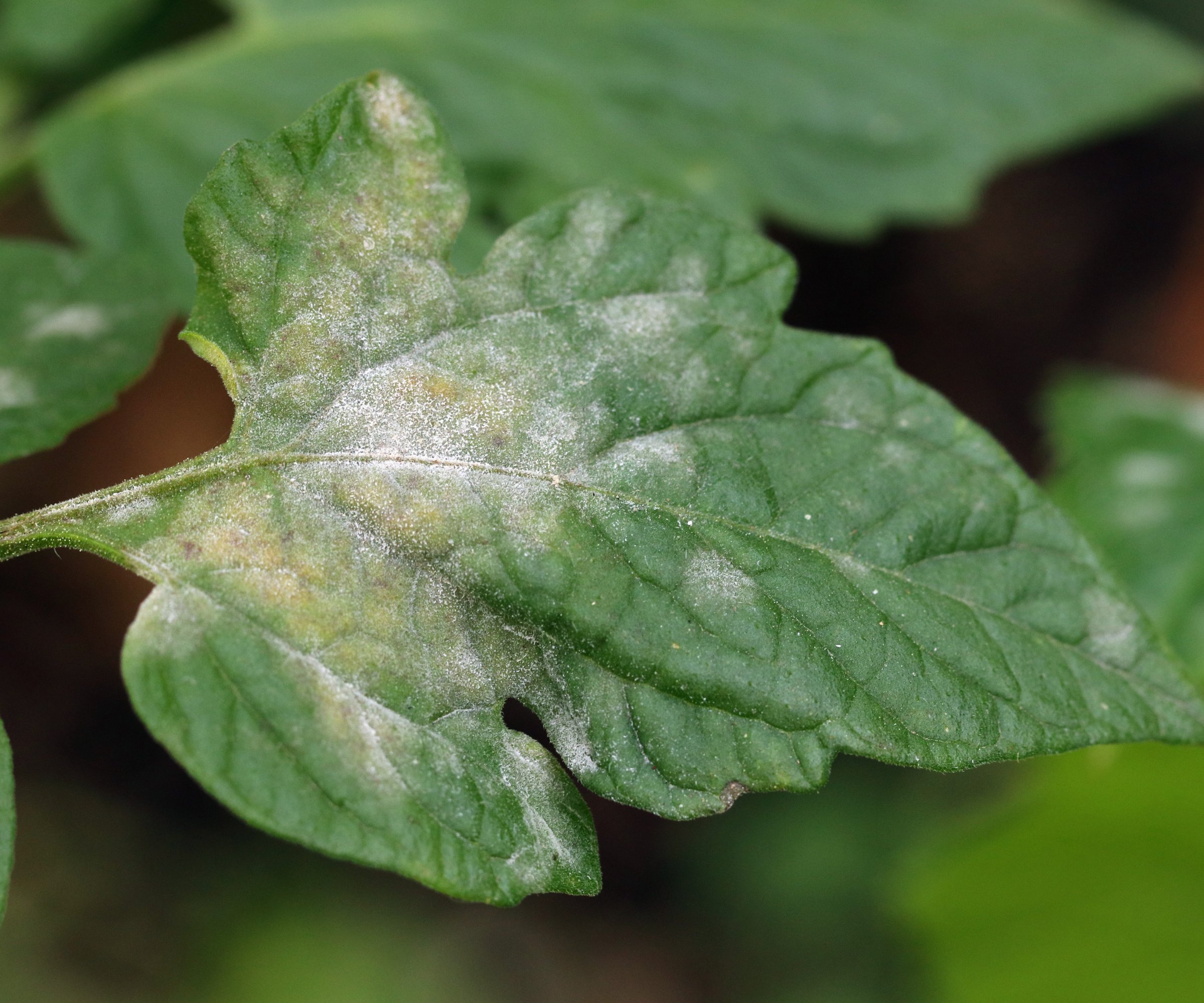
Powdery mildew should be included in any list of tomato diseases. They are found where plants are closely planted and air circulation is poor and will normally look like a powdery substance on the leaves.
Bacterial Tomato Diseases
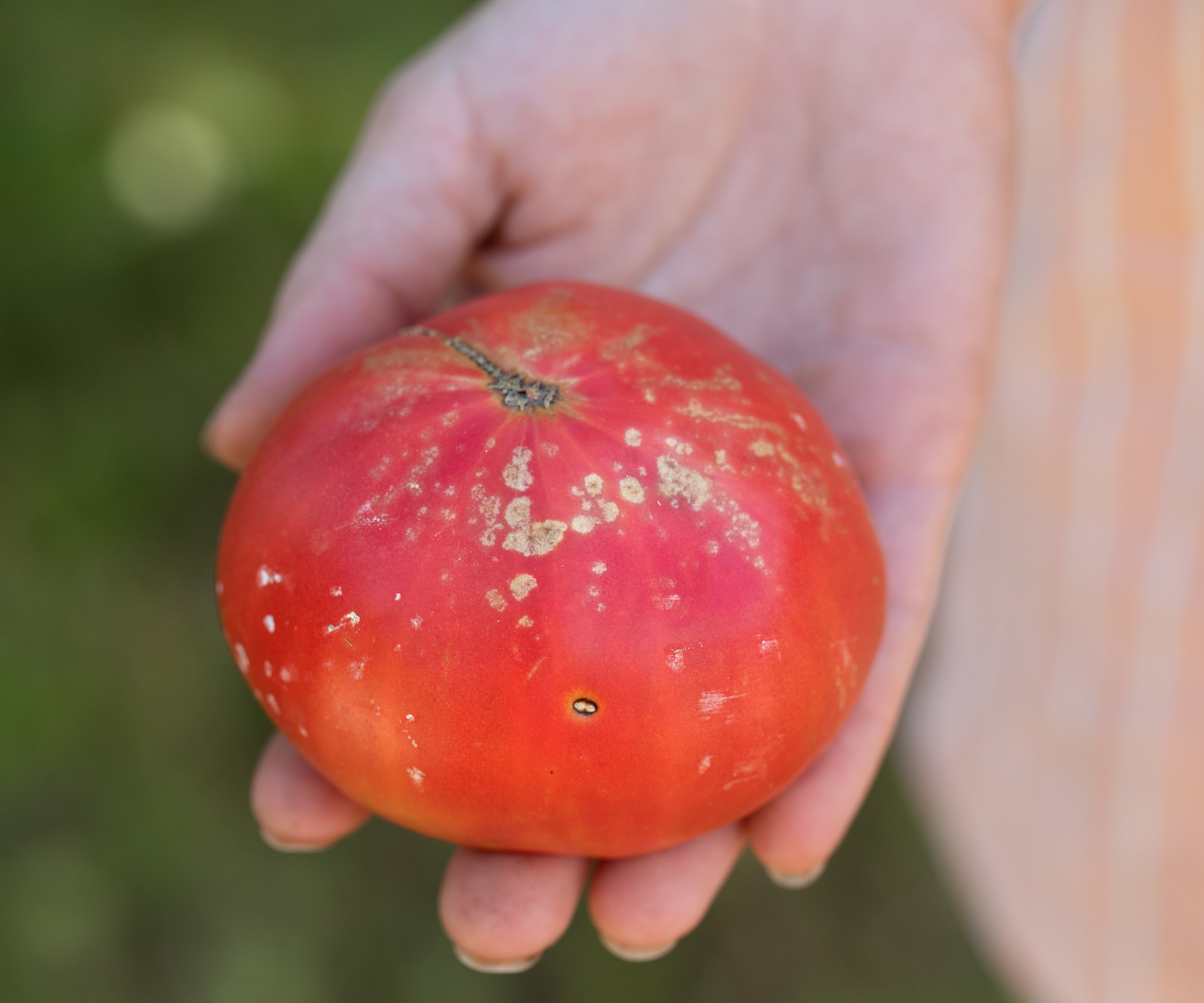
Bacterial diseases are caused by microscopic, single-celled organisms that multiply quickly. They are usually transmitted via contaminated seed or transplant and spread in the rain, or wind or on equipment, people, insects or pets.
Bacterial Spot
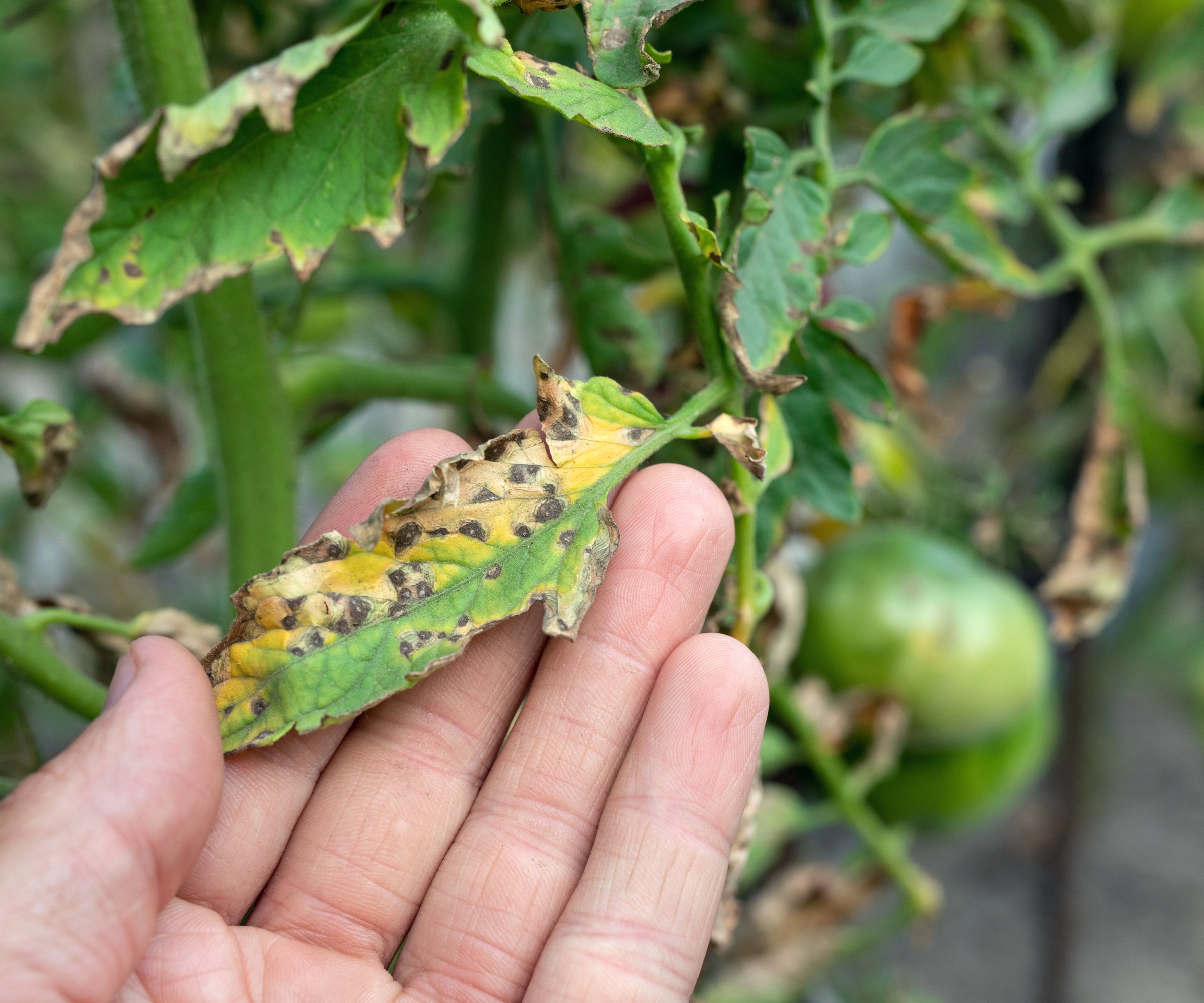
Bacterial spot survives on plant debris and seed and is promoted by wet temperatures from 75-85 F. It appears as dark brown, greasy looking spots on leaves, fruit or stems of the plant at any stage of growth. Heavily spotted areas become chlorotic followed by the rapid death of leaves from lower to higher on the plant.
Spots on green fruit are raised, scabby and dark brown. On ripe fruit, they become more sunken.
These leaf spots look very similar to those caused by another bacterial disease, bacterial speck as well as the fungal disease Septoria leaf spot. Bacterial speck affects both leaves and green fruit causing small dark brown spots with a yellow halo. Like bacterial spot, bacterial speck is fostered by wet conditions but cooler temperatures of 55-77 F.
Control for both diseases is the same. Use certified clean seed and transplants. Remove any plant debris, rotate crops and use drip irrigation to reduce the incidence of these bacterial diseases. Also a weekly application of a mix of copper and fungicide can reduce the incidence of the disease and increase yields.
Bacterial Canker And Wilt
Bacterial canker and wilt are two other bacterial diseases known to afflict tomatoes. Tomato bacterial canker produces a number of symptoms making it difficult to diagnose while bacterial wilt results in rapid wilting of the entire plant coinciding with brown decay inside the stems of the plant. Bacterial wilt is easy to diagnose. When the stem is cut open, is disgorges a slimy, milky stream
The bacterial canker pathogen is transmitted by seed or transplants and can survive for a time on plant debris and on nightshade weeds or volunteer tomato plants. It is spread through water splash, garden equipment, and activity in and around the plants.
Use certified clean seeds and transplants to control both bacterial diseases. Rotate crops. Bactericides are not effective. There is no cure for either of these diseases. Remove and destroy infected plants immediately.
Viral Tomato Disease
Alfalfa Mosaic Virus
Alfalfa mosaic is a viral disease with a large host range. In the case of tomatoes, the disease is transmitted by aphids to healthy plants or mechanically. This disease is most commonly present when tomatoes are cultivated near infected alfalfa fields.
Alfalfa mosaic presents as a yellow mosaic pattern on newly emerging foliage combined with extensive browning and splitting of the fruit.
This disease can be prevented by the removal of infected plants and not planting tomatoes near alfalfa fields.
Curly Top Virus
Curly top virus also called western yellows disease is caused by the beet curly top virus. A severe disease of tomatoes, the virus can spread great distances and is transmitted by the beet leafhopper where it can infect any of 300 host plants. Interestingly, leafhoppers do not feed on tomatoes, so their infection is generally solitary, rather than an infection of an entire crop.
Symptoms begin as curly, pale green upper leaves. As the disease progresses, all foliage becomes twisted and pale. Leaves also become thick with obvious purple veining. Early infection of tomatoes will kill the plant.
Control of curly top in tomatoes revolves around reducing the numbers of leafhoppers attracted to them by intercropping, varying the crop pattern and planting tomatoes in shaded areas or covering the fruit with row covers. There are no resistant varieties and insecticides are ineffective.
Tobacco Mosaic Virus
Tobacco mosaic virus is another minor viral disease due to the ready availability of resistant varieties. It is spread by mechanical and human interactions with plants.
Symptoms vary depending upon the strain of virus, but generally present as small, curled and mottled areas on foliage. Fruit is usually unaffected although in some cases, mosaic patterns may be present.
There is no cure for tobacco mosaic virus but again, there are many resistant varieties. Wash hands well after using tobacco products and before handling plants.
Tomato Spotted Wilt
Tomato spotted wilt is the result of two viruses which are spread by thrips in the greenhouse or field and most commonly affect tomatoes and peppers. Fruit loss can be a major issue in areas of high infection early in fruit development.
Symptoms may vary but generally appear as brown spotting of young leaves, stunted growth, and streaking of stems. Ringspots may also be present on foliage. Because symptoms of the disease vary, definitive diagnosis can be made through your local extension office.
Management consists of the use of healthy transplants in the field. In the greenhouse, avoid cultivating veggie transplants along with ornamentals and enclose the structure with thrip proof fine meshed screens. Also inspect any incoming plants for signs of thrip infestation.
Controlling the thrip population with insecticides is ineffective. Plant resistant tomato varieties. Remove and destroy infected plants.
Environmental Tomato Issues
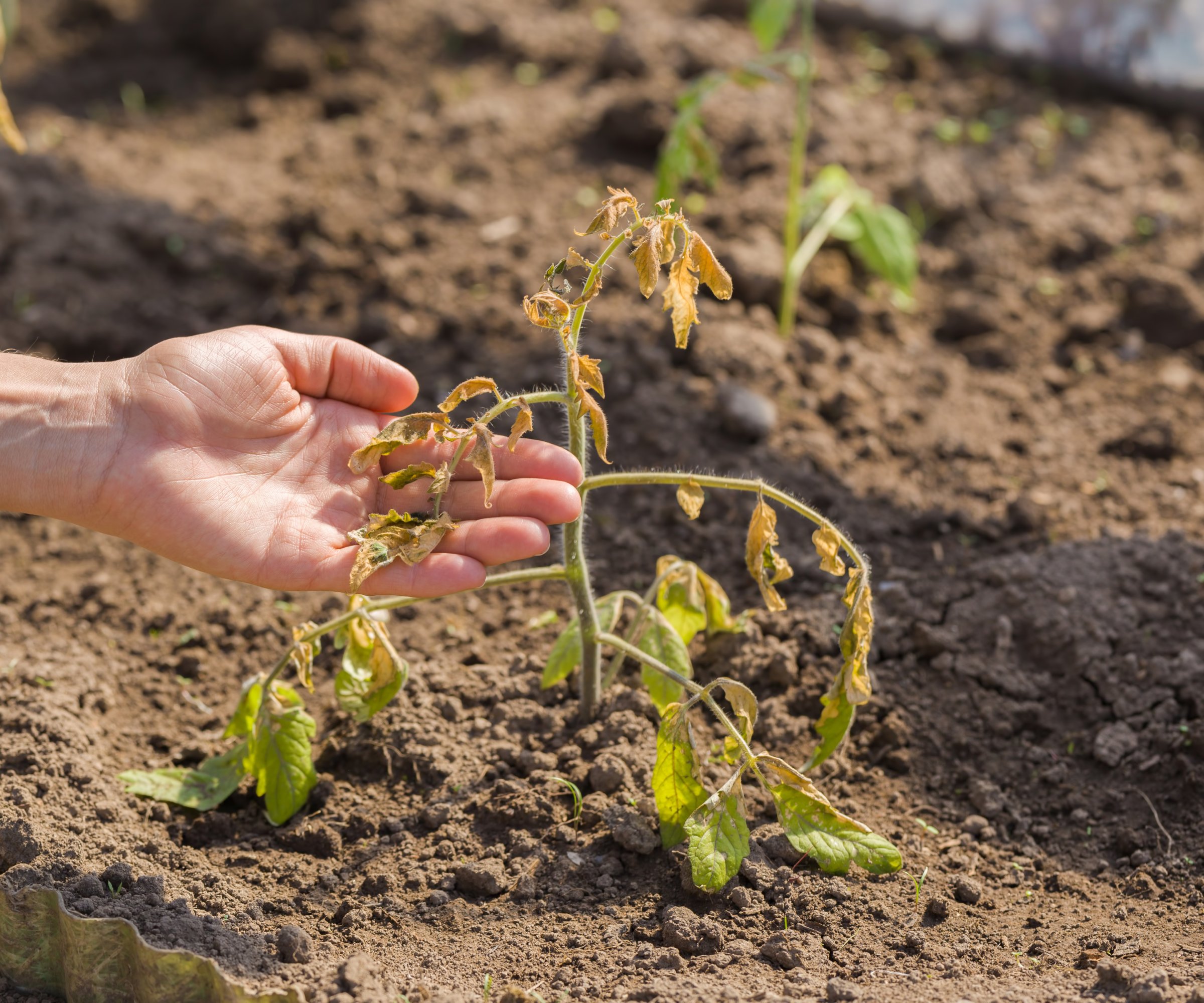
- Temperature, humidity, soil health, and fertilizing can all affect the health of your tomatoes. Temps below 50 F and above 90 F can result in blossom drop and lack of pollination. High humidity makes pollination difficult.
- Arid soils can result in fruit drop and salt rich soil can damage cells and thwart water uptake.
- Too much nitrogen fosters foliage but not fruit growth. In the presence of developing fruit, excess nitrogen results in cracking.
- Cat facing is another issue caused by environmental factors. Cat facing is when the fruit is physiologically damaged resulting in cavities forming at the blossom end of the fruit.
- Herbicide damage, water stress, lack or surfeit of nutrients, frost injury and sunscald are all also the result of environmental stressors or damage.
Frequently Asked Questions
What are the most common tomato diseases?
Tomatoes, unfortunately, are susceptible to many diseases. Some of the most common include bacterial wilt, early blight, late blight, verticillium wilt, Anthracnose, Fusarium wilt and Septoria leaf spot to name just a few.
What do overwatered tomato plants look like?
Too much irrigation can be a bad thing. Overwatered tomato plant foliage may droop or yellow or brown at the tips. They may also get water blisters from water build up. The roots may become slimy and brown or black accompanied by an unpleasant smell of rot. The soil around the plant will feel sodden and may have signs of mold. Mold may also be present on other parts of the tomato plant accompanied by a foul odor.
This article features products available from third-party vendors on the Gardening Know How Shop.

Amy Grant has been gardening for 30 years and writing for 15. A professional chef and caterer, Amy's area of expertise is culinary gardening.
- Jackie RhoadesWriter
- Liz BaesslerSenior Editor
- Amy DraissDigital Community Manager

